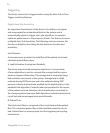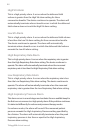Trilogy200 clinical manual
42
Check Circuit Alarm
This is a high priority alarm. It occurs when the device detects a
problem with the patient circuit, such as pinched or detached tubing,
water condensation in the proximal pressure lines, or problems with
the active exhalation device.
Low Circuit Leak Alarm
This is a high priority alarm that only occurs with the passive circuit.
It occurs when the system detects a problem with the leak device in
the passive circuit.
High Expiratory Pressure Alarm
This is a high priority alarm. It occurs when the delivered pressure
exceeds the target patient pressure during the expiratory phase by
5 cmH
2
O. This may be due to pinched tubing or the patient having
a fast breath rate. The device continues to operate. The alarm will
automatically terminate when the delivered pressure comes within
5 cmH
2
O of the target patient pressure during the expiratory phase.
Low Expiratory Pressure Alarm
This is a high priority alarm. It occurs when the delivered pressure
is 5 cmH
2
O or more below the target patient pressure during the
expiratory phase. The device continues to operate. The alarm will
automatically terminate when the delivered pressure comes within
5 cmH
2
O of the target patient pressure during the expiratory phase.
High Internal Oxygen Alarm
This is a high priority alarm. It occurs when there is a leak in the
internal air delivery system that allows oxygen to build up inside
the device. The alarm is generated when the internal oxygen
concentration reaches 5% above ambient levels.


















